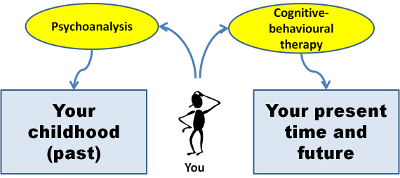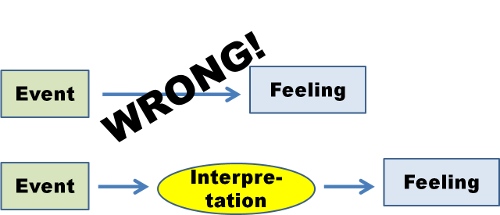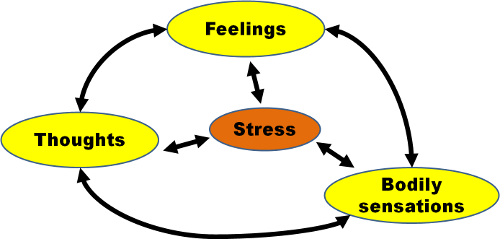Stress Management Part 5
Introduction
This is the fifth and final part of my five-part series about stress management. The previous four parts can be found here:
I recommend reading the blog posts in chronological order.
Non-intuitive Tools
In part 4 we talked about common sense tools for stress management. In this part five, I’m going to list some non-intuitive tools for stress management. As the name suggests these tools are not common sense as the tools listed in the previous part - these non-intuitive tools need some understanding about the human psyche and also some practicing before the tools will make a difference in your capability in stress management and resiliency to stress. The tools are not in any priority order. At the end of each chapter, I’ll provide some books to read for the interested readers.
One word of warning. These tools reflect my perception of current psychology, and I must admit that they are biased toward cognitive psychology.
Cognitive Psychology
The picture below illustrates (an over-simplification) what’s wrong with traditional psychoanalysis (in my opinion).

Psychoanalysis vs. CBT.
Traditional psychoanalysis takes years and the results might not be that good. Cognitive psychology started to challenge traditional psychoanalysis by focusing on the patient’s current situation, his or her current mental concepts, and how to teach the patient healthier mental concepts to handle his or her current problems and how better to manage his or her situation in the future. There are studies that say that concentrating on one’s childhood might in fact be counter-productive. This doesn’t mean that one’s childhood is meaningless, it isn’t. A happy childhood gives one better tools for handling stress as an adult - on average - but you can learn to handle stress also if you experienced not-that-happy-childhood. The point is that you might do better when concentrating on the presence and on the future than on the past.
Cognitive psychology says that your mental problems (like weak stress management capabilities) are often caused by your wrong thought patterns which are usually called negative automatic thoughts. Example. A stressful situation may trigger bad memories which trigger some negative automatic thoughts which trigger unpleasant feelings and bodily symptoms (more about negative feedback loop later). The book I recommend for this chapter lists some of these negative automatic thoughts:
- Catastrophising. In a stressful situation, you might think that everything is going down and one bad event results to another which results to another and so on. The imaginary end result might be a full catastrophe. This is a very typical negative automatic thought which is caused by your distorted sense of reality and self (maybe caused by stress, or childhood or later experiences).
- Generalization. This is another very typical negative automatic thought. If you often use words like “never”, “always” and so on, you might be hooked to generalization. Examples are: “I never succeed in anything”, “I always fail in my relationships” etc. You can’t really always fail in everything you do.
- Mind-reading. This a funny negative automatic thought. When talking to your boss you might say to yourself “She thinks I’m a loser (mind-reading), she thinks I have always failed in all of my projects somehow or the other (mind-reading and generalization) and she probably will fire me in the next lay-off (catastrophising)”. You really can’t look at your boss’s head to see what she is really thinking. You can ask her and listen to her answer - but you cannot read her mind.
- Polarised and rigid thinking. Some people think that their life and the world, in general, are either black or white - and if things won’t go the way they like they feel bad. In reality, life is almost always some shade of grey. Rigid thought patterns make it difficult for you to adapt - and the capability to be flexible is very important for you to handle stress.
- Emotional reasoning. Emotional reasoning makes you draw wrong cognitive conclusions from your emotions. Example. I feel threat -> The person I’m talking to wants to harm me somehow. Very often your feelings might have been triggered by a totally different context (the situation just is similar to some other situation in which you felt stress and the person you are talking to right now has nothing to do with it).
There are many more negative automatic thoughts. The book of this chapter lists and explains in more detail many negative automatic thoughts that may distort your sense of reality and self.The point is to understand how the mind works and recognize these negative automatic thoughts in yourself - and be released by their power that way.
The book I recommend for this chapter is Briers: Cognitive Behavioural Therapy. The book is very easy to read, explains why cognitive therapy works, and is also a very good self-help guide for you to recognize your negative automatic thoughts and to work on them (so that you are not so connected to them anymore).
Interpretation and Narrativity
One school of the cognitive psychology family emphasizes a human being’s ability to interpret his or her own life. You should see your life as a story that can be interpreted in many ways (a narrative aspect to one’s life). So, you have the freedom to interpret your own life mostly the way you like - too often people interpret his or her life in a very negative way (and think that this interpretation is a universal truth - it isn’t). You should be more compassionate to yourself and choose a more positive interpretation in your life. Let’s illustrate this aspect with an example.
- Bad interpretation: My life is a total failure. I couldn’t keep my relationship and I’m stuck with the same job for 10 years. There’s no way anyone would like to have a relationship with me, and there is no future for me at work.
- Good interpretation: We failed with our relationship but I also learned a lot. I think I need to take into consideration my spouse’s wishes better in my next relationship. I enjoy my work and that’s why I have been in the same job for the last 10 years. My superior and my colleagues think highly of me and I’m an important member of our unit.
Did you get the point? It’s the same life but there are several possible interpretations. Don’t pick the darkest and most pessimistic interpretation since it will harm your mental health and make your psyche less resilient to stress. Even with challenging life events, you can think that you have acted well enough taking into consideration your strengths and demanding life at that time. No-one is expecting a perfect outcome for everything in life (a negative automatic thought: rigidness!), good enough is enough.
You should interpret your overall life in a positive and optimistic way. But the same optimism and positiveness apply also to individual situations at work or at home. Look at the picture below.

Interpretation.
If something unpleasant happened at work this may very fast trigger an unpleasant feeling in you. You may think that you have no control between the connections of the events in your life and your feelings. This is wrong. What you might miss here is that you have the freedom to interpret events. And your interpretation may give you very different feelings. Example:
- Bad interpretation: The project manager said that we are behind schedule (event) -> She said it to me because she thinks that it’s my fault (interpretation - and mind-reading!) -> I feel bad and stressed (feeling).
- Good interpretation: The project manager said that we are behind schedule (event) -> She probably meant that the project team should focus more on quality to make the software production more bug-free and therefore to make a faster pace in the next sprint (interpretation)-> Everything is ok (feeling), let’s concentrate more on quality.
I don’t remember reading some specific books about narrativity or interpretation in English, but the book mentioned in the previous chapter also talks a lot about interpretation. For Finnish readers I recommend two books: Katajainen, Lipponen & Litovaara: Voimavarat käyttöön (there is also a paperback edition called Voimaa!) and Furman: Ei koskaan liian myöhäistä saada onnellinen lapsuus. The first book focuses on narrativity and gives some information about burn-out and also various relaxation techniques. The second book focuses on narrativity and one of the messages of the book is that regardless your childhood you can have a happy life as an adult (i.e. your bad childhood will not condemn you to bad adulthood deterministically - maybe you just have to endeavor a little more to find happiness). I have recommended “Voimaa!” book for many friends and colleagues of mine and they have given me feedback that reading the book made them seeing their problems and lives in a different (more optimistic) way.
Meaning of life
An interesting aspect is given by a holocaust survivor Doctor Frankl. Viktor E. Frankl was a young doctor when he was sent to a Nazi concentration camp. Being a doctor Viktor Frankl observed the situation and was amazed by how some prisoners survived and some gave in. He realized that once the desire to live fade away it never returned. And once the prisoner gave in he soon died for some reason or the other. The important insight was the desire to live. And for that desire, you have to see that your life has some meaning. There needs to be some meaning for you to live which gives you energy for your everyday challenges (and in harsher conditions like in a concentration camp the meaning of life can be a life-or-death question).
For doctor Frankl this insight was so strong that he realized the meaning for his own life: he had to survive the concentration camp to write a book about his experiences and his insight about that everyone should search for meaning for his or her life. And he did survive, wrote the book I’m soon about to tell you, started a new therapy form called logotherapy, and successfully helped his patients to find their meaning for their lives during his career as a distinguished doctor.
The book of this chapter is Viktor E. Frankl: Man’s Search for Meaning (which is an extended edition of his original book From Death-Camp to Existentialism). The book has been translated into Finnish under the name Ihmisyyden rajalla. If you feel that your life is full of challenges and you can’t survive under the pressure I recommend reading the book’s first part which gives a very detailed illustration of a prisoner’s life in a death-camp. Word of warning: If you easily feel anxious e.g. when watching agonizing movies, don’t read the book.
Stop Brooding Your Worries
One way to lower your stress levels is just to stop brooding (ruminating) your worries. Easier said than done. But with some help and practice, you might learn how to do that. The technique is very much in line with cognitive psychology in general. You may have some negative patterns in your thinking which are not very helpful when you think about your worries. One good way is to sort your worries into three categories:
- Worries that you can handle right away: These are real problems or challenges or worries that you can solve right away. You are allowed to brood the problem a couple of minutes, then think concrete ways how to solve the problem and solve it.
- Worries that you need to handle later: Ok, there is nothing to do about it right now, therefore no need to brood it now.
- Worries that you have no control: Like the possibility of world war III or how your boss thinks about you. There’s almost nothing you can do to prevent world war III (if it ever comes) and you can’t see your boss’s mind (mind reading!). No need to worry about these things.
Usually brooding your problems will not make your problems disappear but it will affect your psyche in such a way that it will just lower your resiliency to stress and may finally even trigger depression. Stop brooding.
The book of this chapter is Robert L. Leahy: The Worry Cure: Seven Steps to Stop Worry from Stopping You. Real self-help. I read the Finnish version and I must say that I didn’t like the book so much as the other books mentioned in this article. But the writer does have a point about the fact that we should worry less.
Mindfulness
The next tool is mindfulness. This tool is also the most controversial and might raise a lot of doubts. But be patient and read the following text with thought.
Let’s first look at the Vicious Negative Feedback Loop of Stress.

The Vicious Negative Feedback Loop of Stress.
Stress is a dangerous beast since it will trigger various feelings, thoughts, and bodily sensations. Feelings can then trigger other thoughts and bodily sensations, thoughts can trigger other feelings and bodily sensations and so on. This could lead to a very dangerous and vicious negative feedback loop which strengthens itself (well, in engineering we would call it positive feedback, but psychologists are not engineers).
Mindfulness-based therapy says that you cannot reason away from your feelings. You can just feel them. There is no point in fighting against how you feel; the feelings will usually just get stronger. This is an important insight: Your feelings are like a river; if you fight against it the river will just flow more wildly. But if you just observe the river from the river bank with compassion the river may lose its power.
Another insight is that your feelings and thoughts are not you; they are just feelings and thoughts. Mindfulness is about observing these feelings, thoughts, and bodily sensations without force or criticism. The background mechanism is that mindfulness practices (when practiced on a regular basis) will finally weaken the harmful neural connections in your brain how events in your life trigger memories and those memories trigger negative feelings and thoughts and the vicious negative feedback loop will rage like a wild river and you think that you have no way to control that wild river. The events themselves don’t trouble us but the way how we relate to them will. You cannot stop the triggering of unhappy memories or negative automatic thoughts - but you can stop the vicious negative feedback loop from feeding itself and triggering the next negative memories, feelings, and thoughts.
Mindfulness mediation is not a religion, it is not difficult to learn and it doesn’t take a lot of time. And there is clinical evidence that it works for stress management and for the risk of depression relapse, so why don’t you give it a try.
The book of this chapter is Williams & Penman: Mindfulness. If you don’t want to invest in the book before you are more convinced that mindfulness works, why not listen to prof. Mark Williams’ podcasts and read other related material regarding mindfulness, what kind of clinical evidence there is and why it works:
- http://franticworld.com/ : The website for the book. Gives short answers what mindfulness is and how it can help you to handle stress and even more serious mental problems like depression.
- http://podcasts.ox.ac.uk/series/new-psychology-depression -> podcasts number 4, 5, and 6 give information about mindfulness in depression treatment (can also be applied to lower stress).
If you don’t bother to read or listen to the material above, let’s give you the definition of mindfulness given by prof. Williams:
“Mindfulness is a very simple form of meditation that was little known in the West until recently. A typical meditation consists of focusing your full attention on your breath as it flows in and out of your body. Focusing on each breath in this way allows you to observe your thoughts as they arise in your mind and, little by little, to let go of struggling with them. You come to realize that thoughts come and go of their own accord; that you are not your thoughts. You can watch as they appear in your mind, seemingly from thin air, and watch again as they disappear, like a soap bubble bursting. You come to the profound understanding that thoughts and feelings (including negative ones) are transient. They come and they go, and ultimately, you have a choice about whether to act on them or not.”
Final Words to the Stress Management Series
This article is the fifth and last part of my stress management series. In these five parts, I have summarized my knowledge about stress management, what’s the background of stress, and what common sense and non-intuitive tools there are to handle stress. I might add to this stress management category some other more specific articles later on.
I hope you can now better understand what stress is all about and you also found some common sense and non-intuitive tools to manage stress. Stress management and taking care of your mental health is just as important as taking care of your physical health - but one often forgets this in our modern world of haste.
The writer has double majors: Master of Arts (Psychology) and Master of Science (Software Engineering). The writer has spent his career in the field of software industry but still reads various psychology related articles with great interest.
Kari Marttila
Kari Marttila’s Home Page in LinkedIn: https://www.linkedin.com/in/karimarttila/
